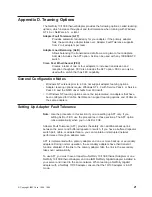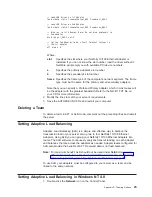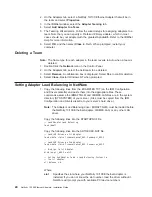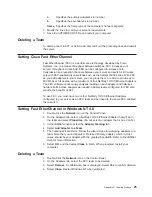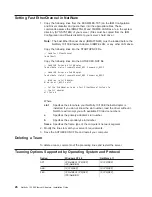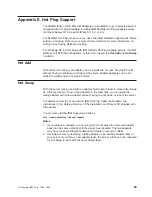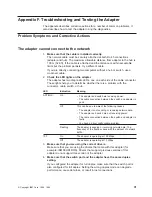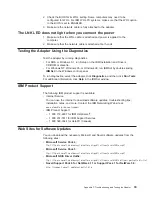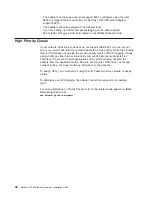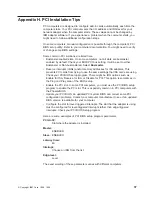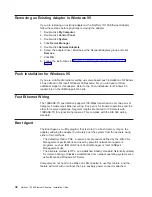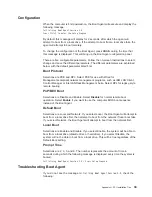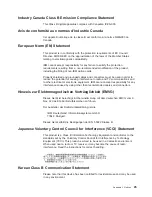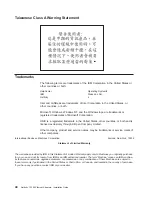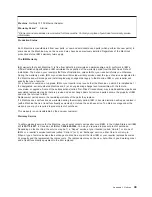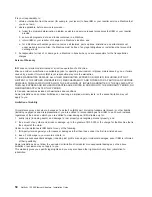
Appendix G. Priority Packet: An Overview
Priority Packet is a traffic-prioritization utility that enables you to set up filters to
process high-priority traffic before normal traffic. Using Priority Packet, you can set
up filters to give priority to critical applications or users.
Priority Packet is available on the IBM Networking Web site at:
www.networking.ibm.com/support
Prioritizing Network Traffic
Priority Packet lets you set up priority filters to send information from critical nodes
or applications with an indicated priority. By prioritizing traffic at the host or entry
point of the network, network devices can base forwarding decisions on priority
information defined in the packet.
Priority Packet prioritizes traffic based on priority filters. These are parameters you
assign to outgoing (transmit) packets. Using the Priority Filter Wizard, you can set
up predefined or custom priority filters based on a node (MAC) address, Ethernet
type, or by various properties of the protocol and port. Priority Packet provides two
different methods for prioritizing traffic: IEEE 802.1p tagging and High Priority
Queue.
IEEE 802.1p Tagging
IEEE 802.1p is a new IEEE standard for tagging, or adding additional bytes of
information to, packets with different priority levels. Packets are tagged with 4
additional bytes, which increase the packet size and indicate a priority level. When
these packets are sent out on the network, the higher priority packets are
transferred first. Priority packet tagging (also known as Traffic Class Expediting)
allows the adapter to work with other elements of the network (such as switches
and routers) to deliver priority packets first. 802.1p tagging enables you to assign
specific priority levels from 0 (low) to 7 (high).
Using the IEEE 802.1p standard for packet tagging, you can assign values to
packets based on their priority. This method requires a network infrastructure that
supports packet tagging. The routing devices receiving and transferring these
packets on your network must support 802.1p for tagging to be effective.
After you set up the priority filter in Priority Packet, you must launch IBMSet and
select 802.1p/802.1Q Tagging on the Advanced tab.
Attention: IEEE 802.1p tagging increases the size of the packets it tags. Some
hubs and switches will not recognize the larger packets and will drop them. Check
your hub or switch documentation to see if they support 802.1p. (You can configure
the switch to strip the tags from the packets and send it on to the next destination
as normal traffic.) If these devices do not support 802.1p or if you are not sure, use
High Priority Queue (HPQ) to prioritize network traffic.
The requirements for effectively using IEEE 802.1p tagging are:
v
The other devices receiving and routing 802.1p tagged packets must support
802.1p.
© Copyright IBM Corp. 1998, 1999
35
Summary of Contents for Netfinity 10/100 Ethernet Adapters
Page 1: ...Netfinity 10 100 Ethernet Adapters Installation Guide IBM ...
Page 2: ......
Page 3: ...Netfinity 10 100 Ethernet Adapters Installation Guide IBM ...
Page 8: ...vi Netfinity 10 100 Ethernet Adapters Installation Guide ...
Page 16: ...xiv Netfinity 10 100 Ethernet Adapters Installation Guide ...
Page 22: ...6 Netfinity 10 100 Ethernet Adapters Installation Guide ...
Page 30: ...14 Netfinity 10 100 Ethernet Adapters Installation Guide ...
Page 32: ...16 Netfinity 10 100 Ethernet Adapters Installation Guide ...
Page 44: ...28 Netfinity 10 100 Ethernet Adapters Installation Guide ...
Page 46: ...30 Netfinity 10 100 Ethernet Adapters Installation Guide ...
Page 50: ...34 Netfinity 10 100 Ethernet Adapters Installation Guide ...
Page 58: ...42 Netfinity 10 100 Ethernet Adapters Installation Guide ...
Page 69: ......

